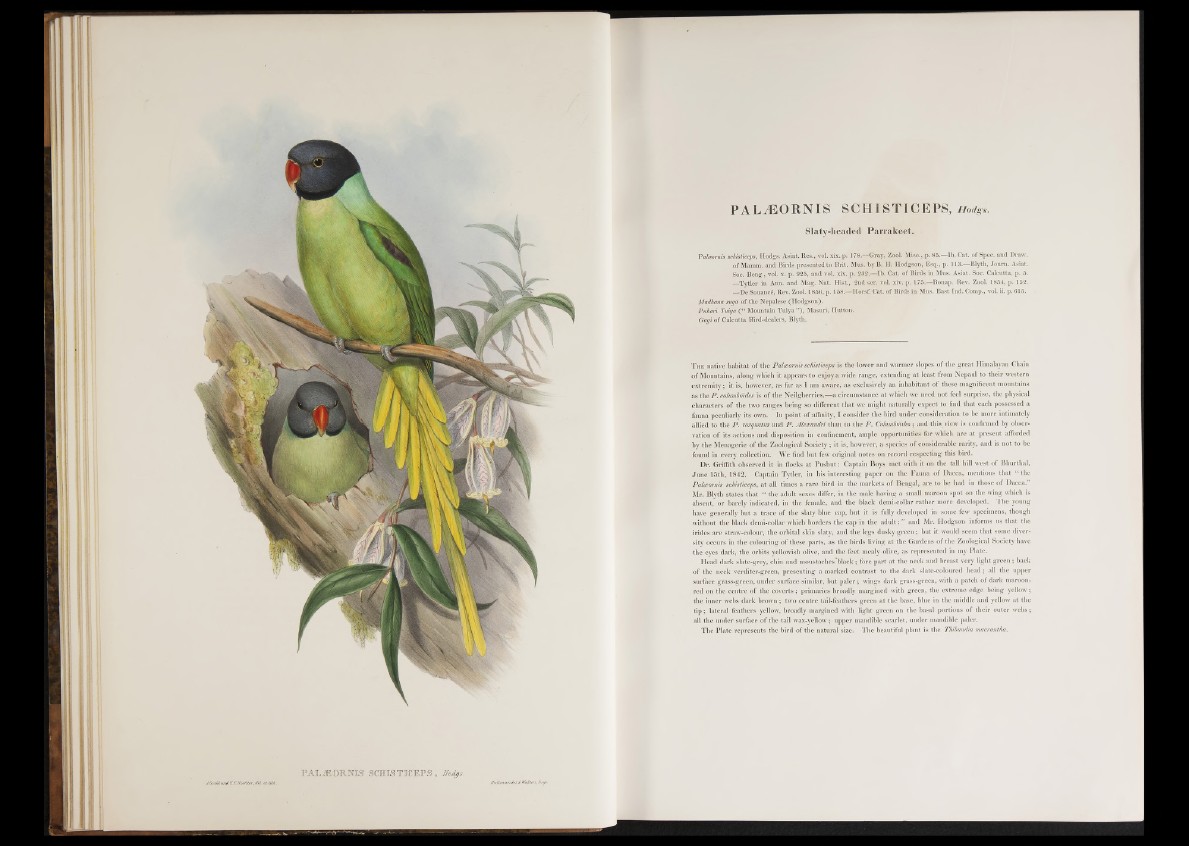
PAlcEORKTIS SCHISTICEPS , M o fy s.
JiuUnucndrl i Wallen, Imp.
PALCEORNIS SCHISTICEPS , Hodgs.
Slaty-headed Parrakeet.
Palceornis sckisticeps, Hodgs. Asiat. Res., vol. xix. p. 1.78.—Gray, Zool. Misc., p. 85.—Ib, Cat. of Spec, and Draw.
of Mamm. and Birds presented to Brit. Mus. by B. H. Hodgson* Esq., p. 113.—Blytb, Journ. Asiat.
' Soc. Beng i vol. x. p. 925, and vol. xix. p. 232.—Ib. Cat. o f Birds in Mus. Asiat. Soc. Calcutta, p. 5.
—Tytler in Ann. and Mag. Nat. Hist., 2nd s e r # o l, xiv. p. 175.—Bonap. Rev. Zool. 1854, p. 152.
—De Souance, Rev. Zool. 1856, p. 158.— Horsf. Cat. of Birds in Mus. East Ind. Comp., vol. ii. p. 615.
Madhana suga of the Nepalese (Hodgson).
Puhari Tuiya ( “ Mountain Tuiya ”) , Masuri, Hutton.
Gagi of Calcutta Bird-dealers, Blyth.
T h e native habitat o f the Palceornis schisticeps is the lower and warmer slopes o f the great Himalayan Chain
o f Mountains, along which it appears to enjoy a wide range, extending at least from Nepaul to their western
extremity; it is, however, as far as I am aware, as exclusively an inhabitant o f these magnificent mountains
as the P . columboides is o f the Neilgherries,— a circumstance at which we need not feel surprise, the physical
characters o f the two ranges being so different that we might naturally expect to find that each possessed a
fauna peculiarly its own. In point o f affinity, I consider the bird under consideration to be more intimately
allied to the P . torquatus and P. Alexandri than to the P . Columboides \ and this view is confirmed by observation
o f its actions and disposition in confinement, ample opportunities for which are at present afforded
by the Menagerie o f the Zoological S o c ie ty ; it is, however, a species o f considerable rarity, and is not to be
found in every collection. We find but few original notes on record respecting this bird.
Dr. Griffith observed it in flocks at Pushut: Captain Boys met with it on the tall hill west o f Bhurthal,
June 15th, 1842. Captain Tytler, in his interesting paper on the Fauna o f Dacca, mentions that “ the
Palceornis schisticeps, at all times a rare bird in the markets o f Bengal, are to be had in those o f Dacca.
Mr. Blyth states that “ the adult sexes differ, in the male having a small maroon spot on the wing which is
absent, or barely indicated, in the female, and the black demi-collar rather more developed. The young
have generally but a trace o f the slaty blue cap, but it is fully developed in some few specimens, though
without the black demi-collar which borders the cap in the a d ult: ” and Mr. Hodgson informs us that the
irides are straw-colour, the orbital skin slaty, and the legs dusky g r e en ; but it would seem that some diversity
occurs in the colouring o f these parts, as the birds living at the Gardens o f the Zoological Society have
the eyes dark, the orbits yellowish olive, and the fe et mealy olive, as represented in my Plate.
Head dark slate-grey, chin and moustaches'black; fore part at the neck and breast very light green ; back
o f the neck verditer-green, presenting a marked contrast to the dark slate-coloured h ead ; all the upper
surface grass-green, under surface similar, but p a le r ; wings dark grass-green, with a patch o f dark maroon-
red on the centre o f the cove rts; primaries broadly margined with green, the extreme edge being y ellow ;
the inner webs dark brown ; two centre tail-feathers green at the base, blue in the middle and yellow at the
t ip ; lateral feathers yellow, broadly margined with light green on the basal portions o f their outer w eb s;
all the under surface o f the tail wax-yellow; upper mandible scarlet, under mandible paler.
The Plate represents the bird o f the natural size. The beautiful plant is the Thibaudia macrantha.